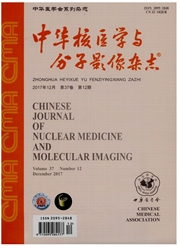

 中文摘要:
中文摘要:
目的探讨18F—FDGPET/CT对肌无力患者的临床应用价值。方法回顾性分析41例2010年8月至2013年11月期间行全身18F-FDGPET/CT检查的不明原因肌无力患者资料,其中男28例,女13例,平均年龄62.6岁。患者最终诊断根据组织病理学结果及长期随访(8—46个月)得出,并获得18F-FDGPET/CT对肌无力患者良恶性病变的诊断效能。结果41例患者中,经组织病理学证实,12例为恶性病变(肺癌6例、淋巴瘤2例、脑胶质母细胞瘤、前列腺癌、肾透明细胞癌和结肠癌各1例),18F-FDGPET/CT均正确诊断;余29例为神经肌肉系统良性疾病,6例18F—FDGPET/CT发现高代谢病灶,2例18F-FDGPET/CT误诊为恶性病变。18F-FDGPET/CT对肌无力患者恶性肿瘤诊断的灵敏度为12/12,特异性为93.1%(27/29),准确性为95.1%(39/41),阳性预测值为12/14,阴性预测值为100%(27/27)。1例皮肌炎患者肌肉葡萄糖代谢弥漫性增高。结论 18F-FDGPET/CT有助于肌无力患者的病因诊断,早期发现潜在的肿瘤病灶,还有助于判断某些周围神经肌肉疾病受累的范围和程度。
 英文摘要:
英文摘要:
Objective To assess the value of lSF-FDG PET/CT in discovering the cause of myas- thenia. Methods Between August 2010 and November 2013, 41 cases (28 males, 13 females; average age 62.6 years) with myasthenia who underwent whole-body lSF-FDG PET/CT were enrolled in this retro- spective study. The final diagnoses were based on histopathology and clinical follow-up (8-46 months), and the detecting efficiency of ISF-FDG PET/CT in patients with myasthenia was calculated. Results Of the 41 patients, 12 were histologically confirmed as having a malignancy including lung cancer (n = 6), lymphoma ( n = 2), spongioblastoma ( n = 1 ), prostate cancer ( n = 1 ), renal clear cell cancer ( n = 1 ) and colon canc- er (n= 1). lS F-FDG PET/CT could detected all the primary malignancies and metastases. In 29 patients with benign diseases, abnormal FDG uptake lesions were found in 6 cases, and the rest 2 cases had false- positive results. The sensitivity, specificity, accuracy, positive predictive value and negative predictive val- ue of ISF-FDG PET/CT in detecting tumors in patients with myasthenia was 12/12, 93.1% (27/29), 95.1% (39/41), 12/14 and 100% (27/27), respectively. FDG uptake in muscles increased diffusely was found in 1 patient with dermatomyositis. Conclusions 18F-FDG PET/CT is helpful to find causes of myas- thenia and can demonstrate the underlying malignancy in the early stage. It could also reveal the range and the extent of some patients with peripheral neuropathy and muscle diseases.
 同期刊论文项目
同期刊论文项目
 同项目期刊论文
同项目期刊论文
 A Novel 99mTc-Labeled Molecular Probe for Tumor Angiogenesis Imaging in Hepatoma Xenografts Model: A
A Novel 99mTc-Labeled Molecular Probe for Tumor Angiogenesis Imaging in Hepatoma Xenografts Model: A 期刊信息
期刊信息
